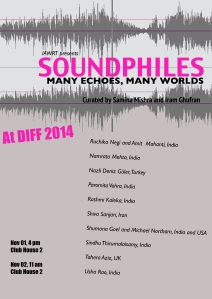Could you tell us about the exact moment (or period of time) when the idea of Soundphiles came to you first? Was it during the editing of a film, or while listening to a radio broadcast?
Soundphiles came up as an idea at an informal meeting of IAWRT members. This is an association of women working in the media. The international body has strong broadcast associations but the India chapter is much more mixed and there are a lot of documentary filmmakers as well as people who work in mainstream radio and TV. We organise an annual film festival in Delhi and so at the meeting, some of the women who work in radio began a conversation about how there is no space to experiment with sound even at our own festival. From that the discussion went on to talk about the role of sound in our diverse practices and so we thought we should plan something at the next festival. And that’s where the idea took off from.
In contemporary culture and the media, sound has unfortunately been reduced to playing a merely complimentary role to that that is visible. It is used either to reinforce the coherence of a diegetic space, or to sustain the illusion of the visible. How do you, with Soundphiles, seek to ensure that sound is appreciated for its own, inherent qualities – intonation, frequency, timber, semantic function – as opposed only to its evocative function?
By removing the visual! In our conversations about curating Soundphiles, we felt that sound practice is available today on the radio or in the contemporary art space. So, we thought, as practicing filmmakers, it would be interesting to use the cinematic space – but just for sound. What would it be like to sit in a darkened auditorium and listen but not see anything? How would we respond? What would we imagine? As filmmakers, we know that while the visual is limited by the frame, sound is limitless and in film, is used to evoke more than what is visible. So we wanted to focus on that aspect of sound and emphasise the ability of sound to tell a story, to evoke an experience or just reflect a space and time. We are thinking of sound in formal terms but the content, narrative, evocation are all crucial. For us, a very important aspect of sound is also the question of access. It’s important to broaden the frameworks of expression and to include all kinds of practices – so we are not so hung up on sound quality – it’s great if the sound recording is good but even if it’s just been recorded on a cell phone, the act of recording is important.
I gather that Soundphiles is meant to be a public performance. In very practical terms, what are the various aspects that you look into in terms of the performance space to ensure maximum audience engagement with the material? Is there a specific sound-system, a definite volume, do you insist on the lights being switched off, are there headphones that are distributed to the members of the audience, etc.?
We would like Soundphiles to work in promoting a collective listening culture. Soundphiles is not curated like a sound installation in a gallery – you are not meant to pass through the work. In terms of its dissemination, we see it more like cinema – it’s just like a screening except there’s no picture. It’s a collective listening, like radio used to be a few decades ago. The works themselves may have been made for art shows or as a radio programme – but apart from sound practice, we are also focussing on the act of listening together. The audience may be large or small – that’s not so critical. Sometimes there is text – in an ideal situation, we wouldn’t want text as a distraction but because we have spoken word in so many languages, we can’t do without subtitles. But for the rest, the audience sits in a darkened auditorium and listens collectively. So, yes, we like to have a good sound system!
In its stated mission, the IAWRT seeks to ensure that women’s views and values become an integral part of contemporary media. It is easy to look at Soundphiles as an articulation of that purpose – it plays, for instance, a very similar role to social media and its contribution to shaping contemporary discourse around the world. I say this because just like social media, recorded sounds too function through qualities of anonymity, gentle subterfuge, a democracy of opinions and omnipresence. How do you view the political aspect of Soundphiles, and is it a part of your original curatorial intent?
All artistic practice is an endeavour towards engaging with the world and influencing how we look/understand/imagine it. So, politics is layered into that. At the IAWRT film festival, we seek to present the myriad ways in which women engage with the world and so, Soundphiles is an extension of that – how do we women engage with the world through sound practice. In the first edition, we curated work under the theme of Many Echoes, Many Worlds and that has a political context to it – there are diverse women with diverse experiences and yet is there something that can resonate across those diversities? Art should spark off conversations, generate dialogue, provoke reflection. Art that emerges from sound practice can do the same.
Samina Mishra and Iram Ghufran in conversation with Anuj Malhotra at DIFF
